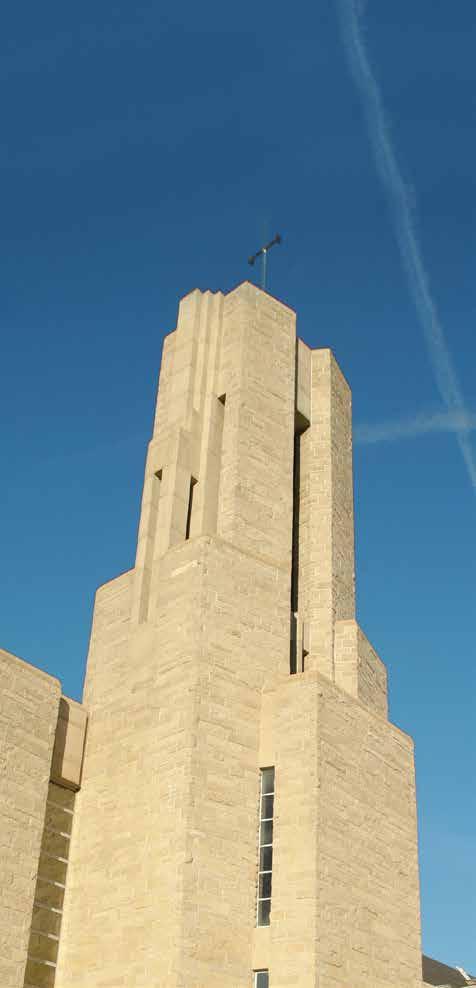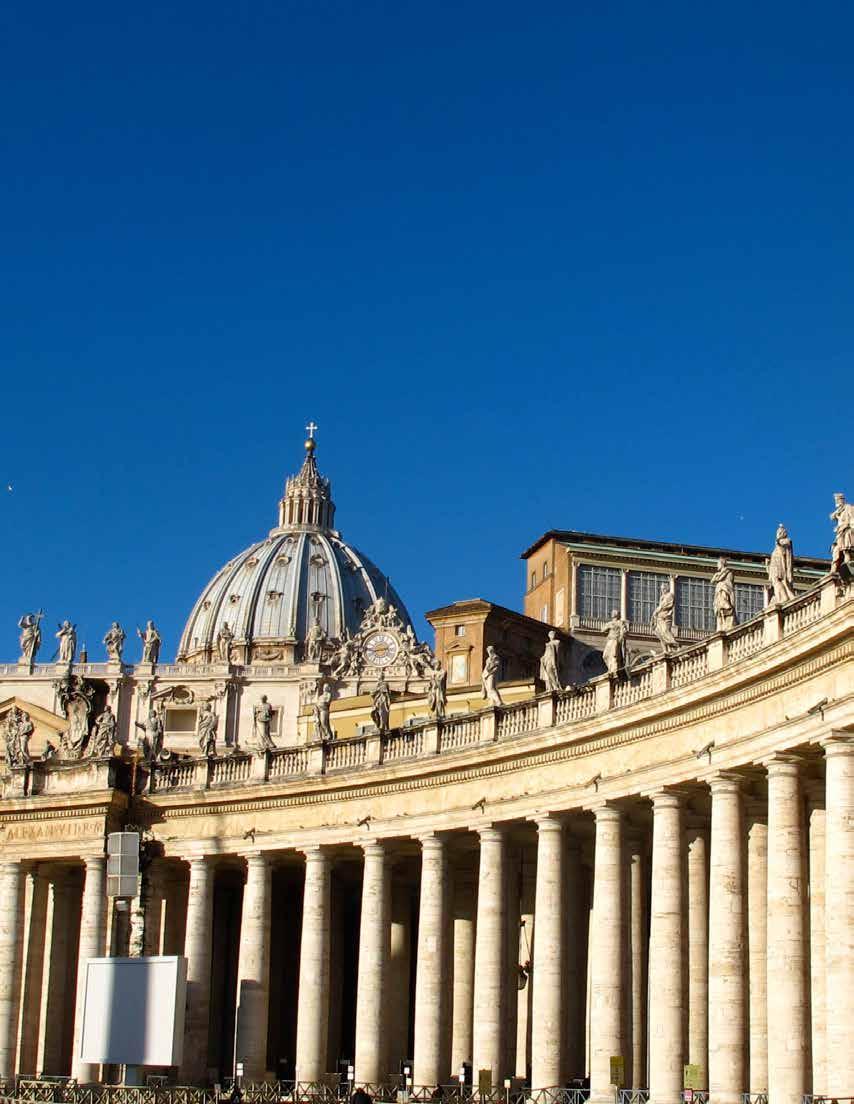
7 minute read
A Future & A Hope
Father Matthew Habiger, benedictine monk since 1963, and Brother Leven Father Matthew Habiger and Brother Leven Harton discuss the exciting changes in the Church and our new leaders both here at the Abbey and in Rome. Harton, benedictine monk since 2007 reflect on the timeless strength of the church and discuss the excitement of its future.

In Unison with The Vision
by Father Matthew Habiger
A monastery exists to serve God and his people, who make up the Church, the Bride of Christ. Men are drawn to a monastery and religious life because they want to make Jesus the top priority in their lives. This is what Jesus is calling them to do.
While nurturing their relationship with Jesus through regular prayer, lectio divina and the Sacraments, monks apply their talents and energies to various tasks within the Church.
People look to religious men and women to help them grow closer to God, and discover what he is calling them to do with their lives, how they are to help build up the Body of Christ.
All this requires spiritual leadership. An abbot represents Christ in the monastery as a spiritual father. He is adept in the spiritual life, where he can guide his monks into a deeper relationship with God, while drawing out all their various talents, and placing the monastic community at the service of Jesus and his people.
An abbot, in turn, must be in close harmony with the successor to Peter and with the local bishop. The Holy Father has Jesus’ promise that he will always have a true understanding of Jesus’ plan for the human race in matters of faith and morals. The Pope leads the Church into the ways of God unerringly. When we pay respect to the Magisterium of the Church, we are simply acknowledging one of the great gifts that God has bestowed upon His Church.
Abbot James has the advantage of spending three years in Rome, doing his studies in theology while preparing for the priesthood. He knows the Center of Christianity first hand, and senses the irreplaceable role of the Holy Father. I think that Abbot James is more impressed with the actual teachings of the pontiff than with any analysis of the pope made by people within the Church.
Abbot James will incorporate the teachings and guidance of recent pontiffs, and now Pope Francis, into the vision of St. Benedict’s Abbey. He will guide our abbey into the service of the Church in the new century, while also drawing abundantly from the Benedictine charism. Pope Francis is a man of the people. He loves the simplicity of his patron, St. Francis of Asissi. For him, everything centers about the person of Jesus. He is adept in using contemporary symbols and examples that help people understand the contents of Faith. He will try to draw disparate peoples together. He will help the Church to adapt its God-given purpose for the new century. He will respond to the new vitality of the faith now seen in the Southern Hemisphere. He defends the voiceless: the unborn, the street children, and the victims of human trafficking.
This we can expect from Abbot James. He will lead St. Benedict’s Abbey in unison with the vision the pope has for the Vatican and the Church. His pro-life efforts will use the guidance of Evangelium Vitae. Both he and Father Brendan Rolling organized the early Pro-Life pilgrimages to Washington D.C. that have become a huge testimony by Benedictine College students to the sanctity of all human life. Abbot James’s efforts to foster Catholic identity in our educational apostolate will be based on Ex Corde Ecclesiae. His vision of religious life will be taken from the apostolic exhortation, Vita Consecrata. He frequently draws upon the teachings of recent pontiffs for his own teaching.
My hope is that the good Lord will invite many new members to St. Benedict’s Abbey, where they can grow into spiritual maturity and human completion. Having acquired this depth in their humanity, they will then be prepared to help make our abbey a vibrant center of Catholicism, fully identified with the successor of Peter, and dedicated to growing into holiness. The world sorely needs monastic centers like this to help build up the Body of Christ. Please pray that those men, whom the Lord of the Harvest is calling to St. Benedict’s Abbey, will generously respond to that call.
Father Matthew has been a Benedictine monk since 1963. He is a full-time member of NFP Outreach, traveling the country speaking on God’s plan for marriage, spousal love and family.
by Brother Leven Harton
At the Holy Thursday Mass of the Lord’s Supper, our new Holy Father, Pope Francis, caused a stir by washing the feet of women. Father Denis Meade informed me that the practice of washing the feet by a church leader stems from a practice carried out for centuries by abbots in monasteries. I have heard concern that this action of the Pope could compromise clarity of dogma concerning the rite. Ought women be allowed to participate in this fashion of taking “the place” of the disciples, who had their feet washed?
Understanding this action requires attentiveness to a statement Pope Francis made about his vision of the Church: “We have to avoid the spiritual sickness of a self-referential church. It’s true that when you get out into the street, as happens to every man and woman, there can be accidents. However, if the church remains closed in on itself, self-referential, it gets old. Between a church that suffers accidents in the street, and a church that’s sick because it’s self-referential, I have no doubts about preferring the former.”
As a young person, boiling with unbridled and enthusiastic conviction, this statement by our Holy Father is a real provocation. Like others my age, I strongly desire visible identification, for the security and stability of clear, unambiguous self-definition in the Church. Pope Francis, with these words, and with this liturgical action of washing a woman’s feet on Holy Thursday, has asked me to consider what is primary in the Church’s mission: simply correct and clean dogma, or the manifestation—the Incarnation—of Christ’s love for humanity? What our Holy Father is proposing to the faithful is that our institutional life in the Church, just like any other human institution, is susceptible to the great pitfall of making self-definition into a sort of self-obsession—perpetuating what Pope Francis calls “narcissistic theology.” It is for the Church that he implores her to “get out into the street,” to become Christ’s true Bride by loving self-gift. It is so that the Church might get her self-definition right!
A new era has begun with the election of Pope Francis and it is up to us to follow his lead. As with any reality, we each have the opportunity to let it be a provocation, a chance to see Christ more clearly. This hopefulness is the fundamental conviction of the Christian claim: Christ really is available—he is not a myth. The Holy Father challenges us to burst forth as the Church in acts of charity, to make present he who is able to bring redemption, true satisfaction to man. This is the leadership that we have with Pope Francis, a challenge to us all (both lay persons and monks!) to join him in giving primacy in our lives to the love of Christ. Engaging our day-today circumstances in such a manner, following our Supreme Pontiff in this way, we will manifest the glory of the Church. For this provocation, I am grateful to have a new leader in our Holy Father, Pope Francis!
Pope Francis is the first Pope to welcome women for the feet-washing rite at the Vatican. He regularly welcomed women to the rite while serving as Archbishop of Buenos Aires. By including women in the feet washing rite Pope Francis is seeking to “accentuate the evangelical command of the Lord, ‘who came to serve and not to be served.’” -uniteD states conference of catholic Bishops

Brother Leven has been a Benedictine monk since 2007. He is currently furthering his education with the hope of serving as a professor of english at Benedictine College. He also serves the Abbey as the Vocations Director and runs the Benedict’s Brittle business during the holiday season.










